Norwich Cathedral
| Norwich Cathedral | |
|
Cathedral Church of the | |
|---|---|
|
Norwich, Norfolk | |
| Status: | cathedral |
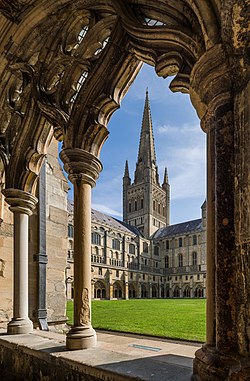 Spire and south transept viewed from the cloisters | |
| Church of England | |
| Diocese of Norwich | |
| Location | |
| Location: | 52°37’55"N, 1°18’4"E |
| History | |
| Built 1096–1145 | |
| Norman, Gothic | |
| Information | |
| Website: | Norwich Cathedral |
The Cathedral Church of the Holy and Undivided Trinity at Norwich, better known as Norwich Cathedral is the cathedral of the Diocese of Norwich in the Church of England, and the seat of the Bishop of Norwich. It stands in the centre of the City of Norwich, the sole city and the county town of Norfolk. Towering over the city, it is Norwich's major landmark, and one of 12 heritage sites in the city.
The cathedral was begun in 1096 and constructed out of flint and mortar and faced with a cream-coloured Caen limestone. An Anglo-Saxon settlement and two churches were demolished to make room for the buildings. The cathedral was completed in 1145 with the Norman tower still seen today topped with a wooden spire covered with lead. Several episodes of damage necessitated rebuilding of the east end and spire but since the final erection of the stone spire in 1480 there have been few fundamental alterations to the fabric.
The large cloister has over 1,000 bosses including several hundred carved and ornately painted ones.
Norwich Cathedral has the second largest cloisters in Britain, only outsized by Salisbury Cathedral. The cathedral close is one of the largest in Britain and one of the largest in Europe and has more people living within it than any other close. The cathedral spire, standing at 315 feet, is the tallest in Britain after that of Salisbury. The spire was being partly rebuilt after being struck by lightning in 1169, just 23 months after its completion, which led to the building's catching fire. Measuring 461 feet long and, with the transepts, 177 feet wide at completion, Norwich Cathedral was until the modern age the largest building in East Anglia.
History
Origins
In 672 the Archbishop of Canterbury, Theodore of Tarsus divided East Anglia into two dioceses, one covering Norfolk, with its see at Elmham, the other, covering Suffolk with its see at Dunwich. During much of the 9th century, because of the Danish incursions, there was no bishop at Elmham; in addition the see of Dunwich was extinguished and East Anglia became a single diocese once more. Following the Norman Conquest many sees were moved to more secure urban centres, that of Elmham being transferred to Thetford in 1072, and finally to Norwich in 1094.[1] The new cathedral incorporated a monastery of Benedictine monks.[2]
Norman period
The structure of the cathedral is primarily in the Norman style]], having been constructed at the behest of Bishop Herbert de Losinga who had bought the bishopric for £1,900 before its transfer from Thetford.[2] Building started in 1096 and the cathedral was completed in 1145. It was built from flint and mortar and faced with cream coloured Caen limestone from Normandy.[3] It still retains the greater part of its original stone structure. An Anglo-Saxon settlement and two churches were demolished to make room for the buildings and a canal cut to allow access for the boats bringing the stone and building materials which were taken up the Wensum and unloaded at Pulls Ferry, Norwich.[3]
The ground plan remains almost entirely as it was in Norman times, except for that of the easternmost chapel. The cathedral has an unusually long nave of fourteen bays. The transepts are without aisles and the east end terminates in an apse with an ambulatory. From the ambulatory there is access to two chapels of unusual shape, the plan of each being based on two intersecting circles.[4] This allows more correct orientation of the altars than in the more normal kind of radial chapel.
The crossing tower was the last piece of the Norman cathedral to be completed, in around 1140. It is boldly decorated with circles, lozenges and interlaced arcading.[4] The present spire was added in the late fifteenth century.[4]
Later Middle Ages
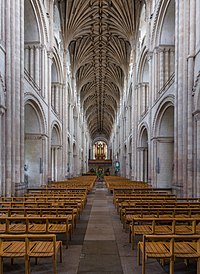
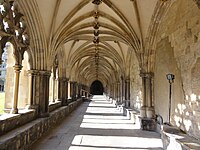
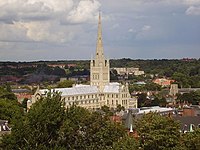
The cathedral was damaged after riots in 1272,[2] which resulted in the city paying heavy fines levied by King Henry III,[3] Rebuilding was completed in 1278 and the cathedral was reconsecrated in the presence of Edward I on Advent Sunday of that year.[2]
A large two-storey cloister, the only such in England, with over 1,000 ceiling bosses was begun in 1297 and finally finished in 1430 after the Black Death had plagued the city.
The Norman spire was blown down in 1362. Its fall caused considerable damage to the east end, as a result of which the clerestory of the choir was rebuilt in the Perpendicular style.[2][4] In the fifteenth and early sixteenth centuries, the cathedral's flat timber ceilings were replaced with stone vaults: the nave was vaulted under Bishop Walter Hart (1446–72), the choir under Bishop James Goldwell (1472–99) and the transepts after 1520.[5] The vaulting was carried out in a spectacular manner with hundreds of ornately carved, painted and gilded bosses. The bosses of the vault number over 1,000. Each is decorated with a theological image, and as a group they have been described as without parallel in the Christian world. The nave vault shows the history of the world from the creation; the cloister includes series showing the life of Christ and the Apocalypse.
In 1463 the spire was struck by lightning, causing a fire to rage through the nave which was so intense it turned some of the creamy Caen limestone a pink colour.[3] In 1480 the bishop, James Goldwell, ordered the building of a new spire which is still in place today. It is of brick faced with stone, supported on brick squinches built into the Norman tower.[4] At 315 feet high, the spire is the tallest in Britain after that of Salisbury Cathedral, which stands at 404 feet.
The total length of the building is 461 feet. Along with Salisbury and Ely the cathedral lacks a ring of bells, which makes them the only three Church of England cathedrals without them.
One of the best views of the cathedral spire is reckoned to be that from St James's Hill on Mousehold Heath.
Seventeenth century
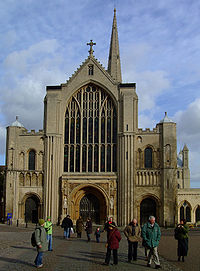
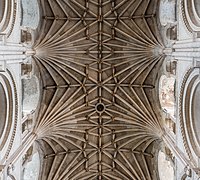
The cathedral was partially in ruins when John Cosin was at the grammar school in the early 17th century and the former bishop was an absentee figure. In 1643 during the reign of Charles I, an angry Puritan mob invaded the cathedral and destroyed all symbols they deemed to elements of 'popery'. The building, abandoned the following year, lay in ruins for two decades. Norwich bishop Joseph Hall provides a graphic description from his book Hard Measure:
It is tragical to relate the furious sacrilege committed under the authority of Linsey, Tofts the sheriff, and Greenwood: what clattering of glasses, what beating down of walls, what tearing down of monuments, what pulling down of seats, and wresting out of irons and brass from the windows and graves; what defacing of arms, what demolishing of curious stone-work, that had not any representation in the world but of the cost of the founder and skill of the mason; what piping on the destroyed organ-pipes; vestments, both copes and surplices, together with the leaden cross which had been newly sawed down from over the greenyard pulpit, and the singing-books and service-books, were carried to the fire in the public market-place; a lewd wretch walking before the train in his cope trailing in the dirt, with a service-book in his hand, imitating in an impious scorn the tune, and usurping the words of the litany. The ordnance being discharged on the guild-day, the cathedral was filled with musketeers, drinking and tobacconing as freely as if it had turned ale-house.
The mob also fired their muskets. At least one musket ball remains lodged in the stonework.
Only at the Restoration in 1660 would the cathedral be restored under King Charles II.
Nineteenth and twentieth centuries
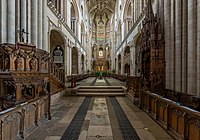
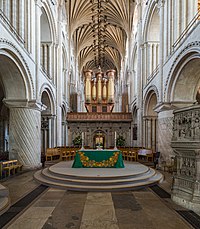
In about 1830 the west front was remodelled by Anthony Salvin.[6] In 1930–2 a new Lady Chapel, designed by Sir Charles Nicholson, was built at the east end, on the site of its 13th century predecessor, which had been demolished during the Elizabethan period.[7]
Modern works
In 2004 the new refectory (winner, National Wood Awards 2004), by Hopkins Architects and Buro Happold, opened on the site of the original refectory on the south side of the cloisters. Work on the new hostry, also by Hopkins Architects, started in April 2007 after the "Cathedral Inspiration for the Future Campaign" had reached its target of £10 million. It was opened by Elizabeth II and the Duke of Edinburgh on 4 May 2010. The new hostry has become the main entrance to the cathedral. Space has been provided within the hostry for temporary art exhibitions.
There is no entry charge to visit the cathedral; visitors are instead asked to make a suggested voluntary donation to help cover the costs of running the cathedral each year.
Furnishings
Norwich Cathedral has a fine selection of 61 misericords, dating from three periods – 1480, 1515 and mid-19th century. The subject matter is varied; mythological, everyday subjects and portraits.
In St Luke's Chapel, behind the altar is a late 14th century painting, known as the Despenser Retable, named after the Bishop of Norwich, Henry le Despenser (1369-1406). During the Peasants' Revolt of 1381, Despenser's forces successfully contained the revolt in Norfolk and the painting was probably commissioned in thanksgiving. Several shields, in the border of the painting, are associated with others who led the attack on the peasants. The retable was re-discovered in 1847, having been reversed and used as a table top.[8]
The copper font, standing on a moveable base in the nave, was fashioned from bowls previously used for making chocolate in Rowntree's Norwich factory, and was given to the cathedral after the factory closed in 1994.
Precinct
The precinct of the cathedral, the limit of the former monastery, is between Tombland (the Anglo-Saxon market place) and the River Wensum and the cathedral close, which runs from Tombland into the cathedral grounds, contains a number of buildings from the 15th through to the 19th century including the remains of an infirmary. The cathedral close is notable for being located within the city's defensive walls and its considerable size, unusual for an urban priory. At 85 acres in size it occupied in mediæval times one tenth of the total area of the city.[9]
The grounds also house the Norwich School, statues to the 1st Duke of Wellington and Admiral Nelson, and the grave of Edith Cavell.
Gates
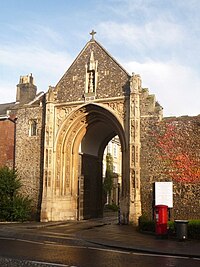
There are two gates leading into the cathedral grounds, both on Tombland. The Ethelbert Gate takes its name from a Saxon church that stood nearby. The original gate was destroyed in the riot of 1272 and its replacement built in the early fourteenth century. It has two storeys, the upper originally a chapel dedicated to St Ethelbert and decorated with flushwork.[10] In 1420 Sir Thomas Erpingham, benefactor to the city, had the gate which bears his name built, sited opposite the west door of the cathedral leading into the close.
Dean and Chapter
The cathedral is led by the Dean. The chapter includes The Vice-Dean and Precentor, the Canon Pastor and the Canon Librarian.
Music
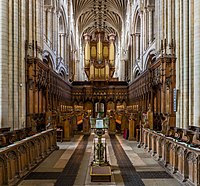
The cathedral's choir is directed by the Master of the Music. The choir consists of boys, girls and men. The boys of the choir hold places for around sixteen boys aged from seven to thirteen years. The boys all attend Norwich School and its Lower School located in the cathedral's close, with at least 50% of their fees being paid by the Norwich Cathedral Endowment Fund. With the men of the choir, the boys sing at five services a week and often more during special times of year such as Easter and Christmas. There are twelve men of the choir, six of them being choral scholars (usually music students from the University of East Anglia). The men of the choir sing with the boys' choir and fortnightly with the girls' choir at Evensong on Tuesdays. The men also sing Evensong on Thursdays by themselves.
The girls of the choir were introduced in 1995 to give girls the chance to contribute to the musical life of the cathedral. It has places for 24 girls, who are older than the boys, at the secondary age of 11 to 18 years. They are drawn from the local community and outside the city. They sing Evensong once weekly (alternately on their own and with the men of the cathedral choir) and at least one Sunday Eucharist a term. The girls sing more often during busy times of the year such as Easter and Christmas.
The choir sing at other churches around the diocese and further afield, release CDs and go on music tours (sometimes all together and at others separately) – locations have included the United States, Malta, Norway and the Netherlands.
Media
The cathedral and other churches in the Diocese of Norwich were featured in the 1974 BBC documentary A Passion For Churches, presented by Sir John Betjeman.[11]
In 2012 Norwich Cathedral and the adjacent Bishop's Palace were featured in the BBC Four documentary The Mediæval Mind: How to Build a Cathedral
The cathedral was used as a location for the 2013 film Jack the Giant Slayer.[12]
The cathedral was also used as a location for the 1971 BBC Christmas ghost story The Stalls of Barchester, based on the story by M.R. James.
Pictures
-
A human figure fighting off a dragon, cloister ceiling detail
-
Cloister ceiling statue showing a group of the faithful
-
The Despenser Retable, late 14th century. The five panels depict the death and resurrection of Christ
-
Baptismal font
Outside links
| ("Wikimedia Commons" has material about Norwich Cathedral) |
- Norwich Cathedral
- Herbert de Losinga
- A history of the choristers of Norwich Cathedral
- Bell's Cathedrals: The Cathedral Church of Norwich – from Project Gutenberg
- Flickr images tagged Norwich Cathedral
References
- ↑ "2: The Dioceses of England: An Outline History". General Synod – Dioceses Commission – Background and History. Church of England. http://www.churchofengland.org/media/40668/chapter2.pdf. Retrieved 3 March 2013.
- ↑ 2.0 2.1 2.2 2.3 2.4 Bumpus, T. Francis (1930). The Cathedrals of England and Wales. London: T. Werner Laurie. pp. 193–97.
- ↑ 3.0 3.1 3.2 3.3 "Timeline of Norwich Cathedral". Norwich Cathedral. http://www.cathedral.org.uk/historyheritage/timeline-timeline.aspx. Retrieved 26 July 2010.
- ↑ 4.0 4.1 4.2 4.3 4.4 Nikolaus Pevsner: Pevsner Architectural Guides
- ↑ Pevsner 1962, p.210
- ↑ National Heritage List 1051330: The Cathedral of the Holy and Undivided Trinity, Norwich
- ↑ Pevsner 1962, pp.211 and 403.
- ↑ "Art Treasures and Despenser Retable". http://www.cathedral.org.uk/historyheritage/art---collections-art-treasures-and-despenser-retable.aspx. Retrieved 30 May 2015.
- ↑ Norman John Greville Pounds (2005). The Mediæval City. Greenwood Publishing Group. pp. 91–92. http://books.google.co.uk/books?id=DOl96eQ2kcgC&pg=PA91&dq=norwich+cathedral+close+europe&hl=en&sa=X&ei=2lIxU-iFJonD7Ab9lYCACg&redir_esc=y#v=onepage&q=norwich%20cathedral%20close%20europe&f=false.
- ↑ Gilchrist, Roberta (2005). Norwich Cathedral Close: The Evolution of the English Cathedral Landscape. Studies in the History of Mediæval Religion,Volume 26. Boydell Press. p. 51. ISBN 9781843831730. http://books.google.co.uk/books?id=JIv9Mb-Vn4MC&pg=PA51&dq.
- ↑ "A Passion For Churches". http://www.bbc.co.uk/iplayer/episode/p022ktzy/a-passion-for-churches. Retrieved 6 October 2015.
- ↑ BBC news item Retrieved 25 March 2013
Pevsner, Nikolaus (1979) [1962]. North-East Norfolk and Norwich. The Buildings of England.
- National Heritage List 1051330: The Cathedral Church of the Holy and Undivided Trinity, The Close
| Cathedrals of the Church of England |
|---|
|
Province of York:
Blackburn •
Bradford •
Carlisle •
Chester •
Durham •
Liverpool •
Manchester •
Newcastle upon Tyne •
Peel •
Ripon •
Sheffield •
Southwell •
Wakefield •
York
|




